Pete Earley's Blog
June 23, 2025
Crying Autistic “Child” Arrested By Florida Prosecutors For Threatening Donald Trump
/>
(6-21-25) Ridiculous! The federal government agreed to drop charges but not state authorities.
Guest Post via email:
Hi Pete, Nick Gallo can’t read or write, has the mental capacity of a child, and an IQ of 50. However, he is accused of posting threats against President Trump. The video of his arrest really paints the picture of who Nick is and what he understands.
Federal prosecutors have dropped their case, citing his cognitive limitations.
Yet, inexplicably, the state of Florida continues to pursue charges. This raises serious questions, especially given Florida statute 916.303, which protects certain mentally disabled individuals from prosecution. (In this case, the doctor told the court that Nick could potentially learn to understand the charges against him in 9 to 12 months)
His mother is also pleading for the charges to be dropped. Nicholas poses no threat, had no means, and no understanding of any wrongdoing.
The case returns to court on July 23 at 1pm. So far, coverage has been limited to one or two local outlets. I believe this warrants a direct question to both Governor DeSantis and President Trump: Why is the state still prosecuting this young man?
Thank you, Thomas Tobin
To reach Florida Governor Ron DeSantis’s office, you can call the main number at 850-717-9337. You can also contact them through their website using the contact form or by mail, sending correspondence to the Governor’s office at the Florida State Capitol.
Governor DeSantis Website comments here.

The post Crying Autistic “Child” Arrested By Florida Prosecutors For Threatening Donald Trump appeared first on Pete Earley.
November 25, 2024
A Graphic Read About Isolation In America’s Toughest Prison Told Through The Eyes Of A Convicted Murderer

(11-25-24) THIS IS NOT ABOUT MENTAL HEALTH.
My twenty-second and last book, No Human Contact: Solitary Confinement, Maximum Security and Two Inmates Who Changed the System, is not for the faint of heart because it describes – often in graphic detail and from a convict’s point of view – life imprisonment in the harshest conditions allowed under the U.S. Constitution.
For 33 years, I corresponded with Thomas Silverstein, who murdered three people while in America’s most secure penitentiary, including a correctional officer. A member of the notorious prison gang, the Aryan Brotherhood, Silverstein spent 36 years in isolation yet he found meaning in his life and ultimately rejected the gang.
His story raises questions about whether nurture or nature creates a killer.
I met him in 1987 in the bowels of Leavenworth prison where I asked him about his decision to attack and savagely stab Merle Clutts, a veteran officer.
Listen to Pete Earley’s taped interview with Thomas Silverstein describing murder that he committed.
Photo from 1987 when I first met Silverstein. Photos before his death in 2019. (Photos copyrighted by Pete Earley Inc.)
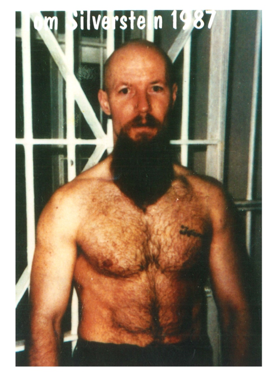
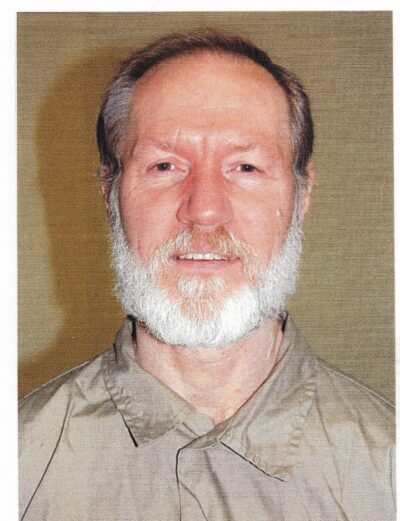
Because there was no federal death penalty in 1983, Silverstein could not be put to death. His actions helped prompt the construction of the first federal Super Max penitentiary where inmates are confined to their cells 23 hours per day with minimum comforts.
The post A Graphic Read About Isolation In America’s Toughest Prison Told Through The Eyes Of A Convicted Murderer appeared first on Pete Earley.
November 22, 2024
A First-Of-Its- Kind Licensed Treatment Center Inside A Jail: Is This The Future In Corrections?

Nashville’s Behavior Care Center is a first-of-its-kind, licensed mental health/addiction treatment facility built inside a jail complex.
(11-22-2024) Are residential mental health and addiction centers located inside jails in our future? Should they be?
Earlier this month, I spoke to an elite group of sheriffs in Nashville attending a Large Jail Network conference. The LJN is composed of senior officials from the largest jails in the United States. This meeting focused on jails becoming the de facto largest public mental health facilities in our country. (The LJN was established in 1989 by the National Institute of Corrections, a part of the U.S. Justice Department.)
Nashville was chosen because Davidson County Sheriff Daron Hall operates a first-of-its-kind 60-bed Behavioral Care Center (BCC) as part of his jail. This is not a separate cellblock where arrestees with mental illnesses and/or addictions are housed and seen by a visiting psychiatrist or social workers. The BCC is a state licensed, residential treatment center adjacent to the jail where individuals charged with crimes – that are clearly linked to their addiction and/or mental illnesses – can have the criminal charges against them dropped if they complete a rigorous treatment regime while incarcerated.
An innovator, Sheriff Hall carved out money from his budget to construct the BCC four years ago. It is a separate, modern building that is only linked to the jail by a single hallway. He told a reporter from the Memphis Commercial Appeal, “I’m interested in why people are here [in jail], not who is here.” That curiosity is what prompted him to create a “specific diversion program aimed at decriminalizing mental illness.”
When I toured the BCC, I couldn’t tell much difference between it and a modern residential treatment center not connected to a jail. It doesn’t look like a jail. Each arrestee receives an individualized treatment plan when they enter the program. The length of stay depends on how well an arrestee does during treatment. You can be returned to jail if you violate the rules. Most arrestees are released after thirty days with the charges against them either being reduced or dropped.
The sheriff’s website states: “Treatment at the BCC includes: Individual Therapy, Group Therapy, Medication Management, Peer Support, and Discharge Planning. After stabilization at the BCC, the discharge specialist’s goal is to connect each resident with community resources and ensure continuity of care. Residents receive follow-up calls after discharge to confirm their plan is still working and to provide additional services as needed.”

Sheriff Hall speaks at BCC which he created
In other words, the BCC does exactly what a well-run and well-funded treatment facility should do – help individuals get the treatment that they need and discharge them with wrap around community services that help them thrive. (This must include access to housing!)
At the conference, I lauded Sheriff Hall for creating the BCC and applauded those sheriffs who expressed interest in creating separate treatment centers as part of their facilities. However, I also mentioned my concerns about creating mental health treatment units inside jails.
No one should have to get arrested to get treatment and constructing jail based centers should never become a way for communities to get around the outdated IMD exclusion or reduce pressure on communities to fund supportive treatment not tied to jails.
We know that law enforcement officers deal with more individuals in mental health crises than psychiatrists do. We also know that forty-percent of individuals with serious mental illnesses will have a potentially volatile confrontation with police. We can’t ignore that some individuals will be arrested and some should. This is why Crisis Intervention Team training, pre-arrest diversion, the Sequential Intercept Model, mental health dockets, and post-division programs are important tools. Based on these realties, what Sheriff Hall has created should help people get treatment and reduce inappropriate incarceration.
But let’s never forget that our goal should be getting people help before they get arrested and the best way to do that is through well-funded community treatment services, especially those aimed at first break psychosis.
The post A First-Of-Its- Kind Licensed Treatment Center Inside A Jail: Is This The Future In Corrections? appeared first on Pete Earley.
November 20, 2024
Expert On Criminalization Of Mental Illness Describes His Personal Journey With Bipolar Disorder
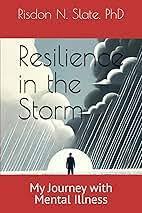
(11-20-24) Risdon N. Slate, an expert about the criminalization of mental illness, has published a memoir, Resilience In The Storm: My Journey With Mental Illness, describing his personal struggles, lessons learned and his recovery. I asked him to share part of his story.
Dear Pete, this chapter captures me in a full-blown manic episode after my psychiatrist decided I was not mentally ill and took me off lithium. Prior to the doctor stopping my medication, I had remained in the closet regarding my mental illness for eight years, telling only significant others that I was bipolar and seeing psychiatrists behind the scenes for meds. I was running from the stigma surrounding mental illness. I was embarrassed. I was ashamed.
After the manic episode, I decided if this could happen to me as a criminology professor with a PhD in criminal justice, work experience as a federal probation officer and as an assistant to the warden at a medium/maximum death row prison it could happen to anyone.
A Wake Up CallThis episode proved to be a wake-up call in my life. Others do not have the connections that I do to help them in times of crisis. I decided to open up regarding my story. Writing a memoir enables me to reach out to a broad audience and provide hope for the possibility of recovery. The process was cathartic as well, helping me make connections between obstacles that I encountered as an illegitimate child with a speech impediment and my mental illness. I use hardships experienced in my youth to bolster me in facing my illness today. In the words of Booker T. Washington. “Success is not measured so much by the position that one has attained in life as by the obstacles one has overcome while trying to succeed.”
RESILENCE IN THE STORM: MY JOURNEY WITH MENTAL ILLNESS
BY RISDON N. SLATE, PhD. Copyrighted. Used by permission from author
PROLOGUE
It was 9:30 on a Sunday morning, Labor Day weekend, when the police came for me.
“That’s my husband,” my wife told the two officers by the pool gate at the condominium complex which we were visiting. “He has a PhD and is a criminology professor.” She felt compelled to tell them this because several minutes earlier I had thrown a lounge chair into the pool, taken off my clothes, and dove in after it.
“He worked in this city as a United States Probation Officer and an assistant warden,” she pled. I was at that moment standing by the side of the pool stark naked. I was relieved to have the police officers intervene and believed justice would ultimately prevail.
My wife was in tears, holding the vial of lithium that I should have been taking. Pointing to the bottle, she told the officers that a doctor had mistakenly taken me off the medication. “Please help him!”
Their help for me was to take me directly to jail.
The officers had me pull on my shirt and shorts and place my hands behind my back as they cuffed me. They placed me in the back of their squad car, where I attempted to tell them about the people conspiring to do me harm.
“Quiet,” one officer insisted as we pulled out.
Always respectful of the police, a few minutes into the ride, when I was given permission to speak, I told them how grateful I was for their intervening and liberating me from the plot against me. They did not respond.
As I entered the housing area of the county jail, the smell was a pungent mixture of bleach and bodily fluids.I was placed in a holding cell with about fifteen other men. I recognized one of my fellow captives as the actor Wesley Snipes playing the role of a detainee. I slid underneath a bench in the cell and huddled with him. I was starving, and he shared his bologna sandwich with me. I appreciated his generosity so much that I tried to hug and kiss him. He, without speaking, deflected my advances by holding the sandwich in in his palm and redirected me to eat the sandwich by pointing to it.
“Hey, Jeff!” I called out to Jeff Bridges, who was acting as another detainee waiting to appear before a magistrate for a bail hearing.
“That is not my name, fool,” he snapped back at me.
I chalked his testiness up to the part he was playing in the film we were making, and I apologized to him for using his real name. He just ignored me.
Unabashedly, I told my fellow detainees, “I worked in that prison just up the road.”
One retorted, “I think I remember you, you son-of-a-bitch.”
I was non-pulsed and excitedly continued my diatribe, informing them, “There is a conspiracy against me involving a federal judge and my ex-wife’s father, which cost me my job as a federal probation officer. I am in this jail until I can figure out my next move.” They looked at me incredulously, but I believed we were all playing our roles.
Further antagonizing the others was my attire: I had made my way into the holding cell wearing my shirt that the cop had handed me to put on back at the pool after skinny dipping. It was a sheriff’s t-shirt from another state commemorating a 5k run with a badge prominently imprinted on it.
I continued with my conspiracy theory, getting in the face of one of my fellow detainees that another had called Jerimiah as I shouted, “I want my probation officer job back.” Jeremiah, a hulking African American, reacted by saying, “Shut up!” He then put me in a headlock, pounded me with his fist on top of the head, and ripped off my shirt. The remnants of the shirt’s collar remained intact around my neck, and I magically believed I would be shielded from harm by this mere piece of cotton encircling my neck.
Nonetheless, I sought cover by laying prone under a bench, where I was comforted by an empty ½ pint milk carton that I thought was sending me a surreptitious message only I could decipher. There was a picture of a missing child on the carton whom the authorities were looking for. I was heartened. The effort made on behalf of that little boy encouraged me not to give up and assured me that people on the outside were working on righting the wrongs that had befallen me and landed me there.
I ultimately had an initial appearance before a magistrate. Disoriented, with no view of the outside world or clock available, I lost track of time. I didn’t know the day or time of my initial appearance before a judicial authority; I would learn later that it took place about seven hours after having been brought to jail. My bail was set at $500, but I could not make it, as I had thrown my wallet onto the roof of the condominium complex in an attempt to shield my identity from the conspirators before the police arrived. Though my wife was present at the hearing, she was unable to make bail. I had hurled all our resources away. We were 500 miles away from home, and she was without an automatic teller machine card, credit card, or sufficient funds. She had even asked my former professor, who owned the condominium where we had been staying, for financial assistance with my bond. However, he declined to help – telling her that he did not want his name associated with my release back into the community. He recommended that she sell my car to acquire sufficient funds. She chose not to do so. My wife was greatly concerned for my well-being but was perplexed as to how to obtain proper care for me. She was not allowed to address the magistrate, but in the courtroom, she told me that she spoke to my guards about my situation. “Don’t worry,” I told her. “I can go back inside. I am protected.”
After not making bail and being returned to the holding cell, I slid up close to another detainee telling him about my previous job at the prison in town, work as a federal probation officer, and my forced resignation from that position. He got in my face and shouted, “Shut the fuck up, or I’m going to knock the shit out of you.” To my surprise, Jeremiah came to my aid, yelling “Leave him alone.” I moved to another corner of the cell.
I had to use the toilet in the cell, and I found myself stymied by the plumbing.Flushing the toilet was beyond my comprehension. With no toilet paper available, I methodically smeared my excrement on my face like war paint.
The jailers began moving detainees one by one from the cell, leaving me housed with an inmate whom I initially mistook for Abraham Lincoln. He was lanky, stooped over, and had a ruddy complexion. However, since he had no beard, I concluded that he was actually U.S. Senator Arlen Specter from Pennsylvania, there to conduct an investigation of the jail.
My unbalanced behavior was manifested through chanting made-up words (“kudabah, wudabah, katori, mingala”) over and over again, coupled with hand over mouth war cries, ritualistic dancing while standing in place with arms outstretched from my sides level with my shoulders, palms up, bringing one knee up as high as possible to my chest. then alternating rhythmically the other knee, and eating the paper containing my charge. This resulted in five guards dragging me out of the cell. They threw me to the concrete floor, kicked and punched me in the ribs, and hog-tied me before moving me to a strip cell. My pain was muted as I drifted outside my body and floated to the ceiling, where I observed the melee below as I was snatched up, restrained, and relocated. They isolated me by moving me to an empty strip cell, with no running water, chair or bed, only a hole in the concrete floor for bodily functions in solitary confinement.
Once in the strip cell, with a magical belief that I would be protected by Native American mysticism that I had been exposed to in a college religion class, I began pounding on the metal walls of the strip cell and peering through the eye slot in my cage when the guards made their periodic checks. As the captors looked in, I proclaimed, “I have a 6th Amendment right to counsel, and I am prohibited from cruel and unusual punishment by the 8th Amendment to the U.S. Constitution. You will soon be hearing from the President of the United States demanding my release.” They did not respond. They just grimaced, shook their heads, and walked away.
I freshened my war paint by fishing through raw sewage in the hole for bodily excretions in the cell’s floor, and I pulled out a broken identification bracelet that had belonged to another inmate. My sole thought–They killed whoever had worn it, and they were going to kill me.
ABOUT THE AUTHOR: Risdon Slate, Professor of Criminology at Florida Southern College, has testified before the U.S. House of Representatives Judiciary Committee, Subcommittee on Crime and was appointed by former Governor Jeb Bush to Florida’s Mental Health & Substance Abuse Commission. 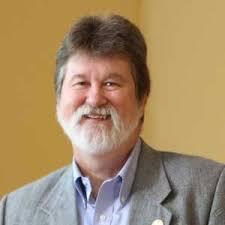 He has been published in numerous scholarly journals and has authored books including Criminalization of Mental Illness: Crisis and Opportunity for the Justice System and The Decision-making Network: An Introduction to Criminal Justice.
Slate received his Ph.D. in criminal justice from Claremont Graduate School, M.S. in criminal justice from the University of South Carolina and B.S. in criminal justice from the University of North Carolina.
He has been published in numerous scholarly journals and has authored books including Criminalization of Mental Illness: Crisis and Opportunity for the Justice System and The Decision-making Network: An Introduction to Criminal Justice.
Slate received his Ph.D. in criminal justice from Claremont Graduate School, M.S. in criminal justice from the University of South Carolina and B.S. in criminal justice from the University of North Carolina.
The post Expert On Criminalization Of Mental Illness Describes His Personal Journey With Bipolar Disorder appeared first on Pete Earley.
November 1, 2024
Shame On Jeff Bezos For Putting Profits Ahead of Responsible Journalism

THIS IS NOT ABOUT MENTAL HEALTH. IT IS ABOUT JOURNALISM.
(11-1-24) I’ve been a working journalist since I turned 17 and I have strong feelings about the freedom of the press and open discussions. Which is why I was disappointed this week when Washington Post owner Jeff Bezos decided to kill an editorial in his own paper. This is not about whether you are going to vote for Donald Trump or for Kamala Harris. Although Bezos attempted to sugarcoat his actions (after more than 250,000 readers canceled their subscriptions), in my view he acted out of fear.
From Bezos’ perspective, his decision make good business sense. His companies do billions of dollars worth of business with the U.S. Government and The Washington Post loses money every year. He didn’t want to offend Candidate Donald Trump who has promised to punish his “enemies.” But as a journalist, he blew it. There is nothing wrong with him using his editorial page to promote his own points of view. But what Bezos did was silence others and that is censorship.
I was so disappointed about his decision that I wrote an Op Ed and submitted to the Post. But its editors rejected it. Here is what I wrote. Again, this is not about Trump and Harris, it is about a newspaper publisher being afraid of a politician and that is untenable.
The Washington Post. Op Ed submission by Pete Earley
As a former Washington Post reporter and life-long journalist, I feel obligated to explain why Jeff Bezos’ decision to censor an editorial supporting the candidacy of Vice President Kamala Harris is both wrong and dangerous. Whether The Post’s choice is Harris or Donald Trump is immaterial. There are higher stakes.
Bezos explains that he was motivated by public surveys that rank journalists and the media at the bottom when it comes to trust and reputation. “Most people believe the media is biased,” he notes. Bias restricts, limits and disregards the opinions of others. As does its twin – censorship. If his decision was aimed at eliminating bias, his actions actually have fostered it.
“We must work harder to control what we can control to increase our credibility,” Bezos writes. The pathway to credibility is not by limiting thoughtful discussion, but by encouraging more of it, including different points of view. Hiring independent ombudspersons and encouraging readers to report errors and comment freely are steps to eliminate bias, not silencing opinions.
Bezos offers an analogy, stating that voting machines must meet two criteria. The machines must count votes accurately and the people must believe they count accurately. The same, he writes, is true of newspapers. This is misleading. A voting machine cares nothing about public perceptions. It counts ballots. A journalists’ job is to investigate and report facts without fear or favor. Whether the public believes the facts should be immaterial to a fact seeker. To do otherwise is to risk pandering and, in fact, promotes bias. This is why reputable news organizations create a wall between news gatherers and editorial writers and columnists.
It is the task of opinion writers to interpret and persuade. Not reporters. The public understands this. And more opinions, not less, is what is needed.
Censoring an editorial does not eliminate bias.
Bezos dismisses the value of his newspaper’s presidential endorsement. While an endorsement might not sway a reader, Bezos has undercut The Post opinion staff, undermining its power to educate and persuade on further issues. What now will separate The Post from a weekly, throwaway shopper that avoids offending readers and advertisers by offering no analyst or opinions, only recipes? Is this not a shirk of public trust and responsibility?
Bezos dismisses any mention about why the press and media rank so low, stating that “a victim mentality will not help.” True, but ignoring reality is equally dangerous. The “main stream” media has been under attack for nearly a decade, chipping away at its credibility in favor of “alternative facts.”
“Complaining is not a strategy,” Bezos argues. Yes, but neither is ignoring the danger in unchecked criticism and promotion of misinformation. With the loss of advertising, too many outlets – especially cable television stations – have hired non-journalists and former political operatives to carve out either a liberal or conservative view to increase their viewership. This is part of what undermines credibility. Passing these folks off as legitimate journalists hurts the profession.
Bezos assured readers that there was “no quid pro quo” while acknowledging an appearance of conflict. “I challenge you to find one instance in those 11 years where I have prevailed upon anyone at the Post in favor of my own interest. It hasn’t happened.” I agree. Until now. Arguing that a thief didn’t steal anything for years before he finally did does not lessen the crime.
Listen to the words of William Allen White for guidance.
I began my career at the Emporia Gazette, home of William Allen White, who penned a Pulitzer Prize winning editorial entitled, To An Anxious Friend, in 1922 after the Kansas governor attempted to arrest and censor any newspaper that sided with striking rail workers. White wrote: “You say that freedom of utterance is not for time of stress, and I reply with the sad truth that only in time of stress is freedom of utterance in danger. No one questions it in calm days, because it is not needed. And the reverse is true also; only when free utterance is suppressed is it needed, and when it is needed, it is most vital to justice.”
It is not too late for Bezos to reverse his decision so that readers can decide for themselves, as they will, whether or not a presidential endorsement is warranted. Silence does not foster credibility. It encourages complicity. Mr. Bezos, William Allen White’s closing comments got it right, not your’s.
White wrote: “This nation will survive, this state will prosper, the orderly business of life will go forward if only men can speak in whatever way given them to utter what their hearts hold – by voice, by posted card, by letter, or by press. Reason has never failed men. Only force and repression have made the wrecks in the world.”
The post Shame On Jeff Bezos For Putting Profits Ahead of Responsible Journalism appeared first on Pete Earley.
September 20, 2024
Dr. E. Fuller Torrey Quits NAMI. Claims Its Focus On “Mental Health” Minimizes Serious Mental Illnesses.

Dr. E. Fuller Torrey quits NAMI
Torrey calls NAMI a Mental Health America “Clone” Embarrassed to belong in advocacy group he once championed.(9-20-24) Dr. E. Fuller Torrey, who played a crucial early role in helping the National Alliance on Mental Illness become the nation’s largest and most influential mental health organization, is ending his 40 plus-year affiliation with the grassroots group, writing in a recent letter: “NAMI is now a sad shadow of its original self, and I am embarrassed to belong. Please cancel my membership.”
In his open letter (see end of blog post) to NAMI CEO and President Daniel H. Gillison Jr., Dr. Torrey explained: “NAMI functioned as a very effective mental illness advocacy organization for almost 20 years. However, by the turn of the new century, it had become clear that, despite its name, the National Alliance for the Mentally Ill was abandoning its focus on mental illness in favor of mental health issues. But it is even worse since NAMI no longer even distinguishes between mental illnesses and mental health problems.”
He was referring to NAMI’s decision several years ago to begin representing all mental health issues – a so-called “big tent” approach- rather than focusing primarily on “serious mentally illnesses, (SMIs)” defined as schizophrenia, schizophrenia, schizoaffective disorder, bipolar disorder, autism, as well as severe forms of other disorders such as major depression, panic disorder, and obsessive-compulsive disorder.
The DSM-5 TR, lists nearly 300 mental disorders grouped into 20 categories. It recently added “prolonged grief disorder.” Torrey has argued for years that NAMI should stick to focusing on serious brain diseases and not all possible mental ailments.
Looking Back To When NAMI Began
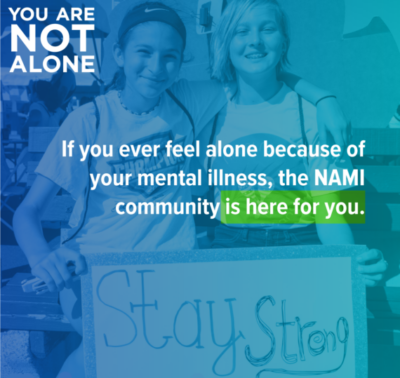
In his letter, Torrey recalled how thrilled he was when NAMI was founded in 1979 by parents, mostly mothers, tired of the “schizophrenic mother” image that blamed them for their children’s maladies.
“Finally, people like my mother had an advocacy group which could provide her with information and support in her attempts to understand my sister’s schizophrenia. In addition, mentally ill individuals who are homeless or incarcerated, and the mental health professionals who provide care for them, would have an advocacy group which could urge federal agencies, such as NIMH and SAMHSA, and state agencies to address their needs.
Torrey explained in his letter that NAMI was not the first national mental health organization. Mental Health America, (MHA) originally called the National Committee for Mental Hygiene, was founded in 1909 by a group of former mental health hospital patients. Traditionally, MHA attracted members who had “lived experience” – a diagnosed mental illness – while NAMI attracted parents and caregivers. Torrey accused NAMI of mimicking MHA:
(NAMI) appears to be transitioning to becoming another Mental Health America .. . NAMI now identifies itself as “the nation’s largest grassroots mental health organization.” (almost identical language as MHA’s credo – ‘a national non-profit dedicated to the promotion of mental health.’” )
Drilling down, Torrey continued:
A Not Surprising Breakup
NAMI’s recent newsletter focused on NAMI’s “Back to School Guide” for children who may have “back to school jitters”. The guide includes a number of fact sheets, posters, and other resources “to foster healthy mental wellness habits” in children. NAMI’s “Back to School Guide” is remarkably similar to Mental Health America’s “Back to School Toolkit”. Which also includes fact sheets, posters, and other resources similar to those offered by NAMI. NAMI has thus become a Mental Health America clone.
But it is even worse since NAMI no longer even distinguishes between mental illnesses and mental health problems. Its website admits that “we intentionally use the terms ‘mental health conditions’ and ‘mental illnesses’ interchangeably”. Thus, NAMI apparently no longer distinguishes between problems such as ‘back to school jitters’ and the fact that 28% of severely mentally ill homeless individuals use garbage cans as a secondary food source with 8% using it as their primary food source.
This is not the first time that Torrey has accused NAMI of abandoning its original focus on brain diseases in favor of all mental health problems. There is a marked difference, he’s written, between serious mental illnesses and ailments of the “worried well” whom he describes as Americans who seek help simply because they have difficultly getting along with other people.
His resignation from NAMI marks the end of an era within NAMI and reveals how much the organization has changed. In a 2001, Washington Post story, NAMI’s first director, Laurie Flynn, discussed how instrumental Dr. Torrey’s support was to the group when it started.
First Signs of Trouble: Rock Star To Outcast
“Torrey had just published “Surviving Schizophrenia,” a guide for patients and their families. When he appeared on Phil Donahue’s TV show to promote it, he urged people seeking help to contact the alliance, which was then a fledgling organization with fewer than 50,000 members, most of them the parents of mental patients. The result was this avalanche of mail.
“Nobody had ever said the word schizophrenia on popular television, and people came out of the woodwork seeking help,” Flynn recalls. “For many years, mothers were told they were the cause of the problem, and here comes Fuller Torrey saying, ‘Wait a minute, this isn’t the family’s fault. These are brain diseases.’ Here was a psychiatrist saying, ‘I know what you’re going through because my sister has the problem.’ It’s hard to overemphasize what a hero he was back in the early days.”
Torrey donated the royalties of “Surviving Schizophrenia” to the alliance and he hit the hustings to organize, helping to build the group into a powerful lobbying organization with more than 220,000 members. (2001 figures)
“Weekend after weekend,” Flynn says, “he went out to states where members were organizing chapters and he rallied the troops. Nobody did it better.”
Throughout the 1980s and into the 1990s, Torrey was revered as a NAMI rock star, frequently appearing at its national conventions. But a crack soon surfaced. The dispute was about Torrey’s championing of Assisted Outpatient Treatment laws (AOTs), which permit mental health professionals, under certain conditions, to require individuals diagnosed with a mental illness to accept treatment even if they do not want it. NAMI agreed to endorse AOT laws but Torrey wanted more. He explained that NAMI’s calls for better and more medical treatments were important, but treatments were meaningless if there were legal barriers keeping the seriously mentally ill from getting help. 
Torrey urged NAMI to create a “treatment advocacy center” within its ranks, primarily to lobby for the passage of AOT laws. Three NAMI board members, at the time, supported his proposal. They were legendary NAMI figures: Fred Frese, D. J. Jaffe, and Carla Jacobs. But NAMI’s affiliates (local chapters) voted “no confidence” in his idea and stopped it from being implemented.
Undeterred, Torrey reached out to Vada Stanley and her husband, Ted, and asked them for financial support. The Stanleys were billionaires, having made their fortune selling collectables, and, as I explain in my book, they had become close with Dr. Torrey after he helped them get treatment for their adult son, Jonathan, after he had a mental breakdown. Ted Stanley later credited Torrey for saving his son’s life. In 1998, the Stanleys agreed to help finance a new non-profit, The Treatment Advocacy Center, with Torrey as its founder. They couple already had created another one of Torrey’s projects, the Stanley Medical Research Institute, to study the brain and had put him in charge. Overall, the Stanley couple would donate more than $825 million dollars to different mental health ventures – money that some in NAMI’s leadership believed should and would have gone to NAMI if Torrey had not created TAC. NAMI Board members Frese, Jaffe, and Jacobs all joined the first TAC board.
Torrey further alienated NAMI leadership in December 1999 when he used NAMI to publish a scathing attack against the National Institute of Mental Health, which he complained was spending too little money for research on severe mental illnesses while funding studies on such topics as “Coping With Change in Czechoslovakia” and the mating habits of the eastern bluebird. Fearful of alienating NIMH and losing federal funding projects, NAMI immediately tried to distance itself from Torrey’s actions.
By the time I became a NAMI member in 2006, the rift between Torrey and his followers and NAMI had widened. More and more individuals with mental illnesses – peers – were joining NAMI and some of them were strongly anti-AOT because they objected to any form of forced treatment. One influential peer serving on the NAMI board threatened to quit if Torrey was invited to speak at the group’s annual convention.
Last Ditch Effort To Change NAMI’s DirectionIn 2013, then NAMI Board President Keris Jan Myrick, a strong peer advocate, startled many in NAMI when she arranged for author/journalist to speak at NAMI’s San Antonio convention. Whitaker had questioned the effectiveness of anti-psychotics and had launched the which often featured bloggers who strongly opposed AOT and frequently vilified Torrey in their writings.
Four years later, backers of Torrey tried to change the direction of NAMI by undertaking a palace coup. At that year’s convention, NAMI was scheduled to fill five seats on its national board. D. J. Jaffe and three others campaigned on what they called a “Focus on Serious Mental Illness” platform. Their actions prompted President Steve Pitman to write a letter before the election endorsing a “big tent” branding approach. Board Member Jim Hayes said someone who was having their life impaired by anxiety was just as worthy of help as an individual with an SMI. None of the four challenging the “big tent” re-branding was elected.
Writing for this blog in 2020, Luna Greenstein, a senior manager at NAMI explained its rebranding goal.
“We are truly the only mental health organization that wants to “be everything to everyone.” While this isn’t always possible, we certainly try.”
Whether NAMI has abandoned the seriously mentally ill by expanding its tent might be debatable, but what can’t be argued is that NAMI’s opening its doors to all mental health problems has increased its reach and enriched its coffers. COVID prompted more attention on mental health which dovetailed with NAMI’s expansive branding. According to Guidestar, which tracks non-profits tax records, in 2023, NAMI reported $48.4 million in gross receipts and listed assets of $78.7 million. In 2011, before the NAMI “big tent” expansion, it was bringing in $9.4 million in gross receipts.
Torrey’s Departure: Afflicting the comfortable and comforting the afflictedWill Torrey’s letter, criticism and departure make a difference? Many of his strongest supporters already left NAMI for TAC. And he has been absent from most NAMI national events for some time. Regardless, being outside the door of an organization that he spent decades helping build will not blunt his criticism. In that Washington Post profile of Torrey, then-NAMI director Flynn stated in 2001:
Cancel My Membership Letter From Dr. Torrey:“Ten years ago, we were outside the door pounding to get in. Now we’re at the table and people expect us to have good manners. But Fuller is still — and always will be — outside the door, pounding to get in.”
Daniel Gillison, CEO National Alliance for the Mentally Ill (NAMI)
Dear Mr. Gillison,
I was recently asked by a friend if I was still a member of NAMI and was embarrassed to answer that I was. In fact, I have been a member for over 40 years and can clearly remember how pleased people were to have a new advocacy organization which was focused on mental illnesses, especially severe mental illnesses. NIMH, at the request of Congress, defined severe mental illness to include schizophrenia, schizoaffective disorder, bipolar disorder, autism, “as well as severe forms of other disorders such as major depression, panic disorder, and obsessive-compulsive disorder.”1 Finally, people like my mother had an advocacy group which could provide her with information and support in her attempts to understand my sister’s schizophrenia. In addition, mentally ill individuals who are homeless or incarcerated, and the mental health professionals who provide care for them, would have an advocacy group which could urge federal agencies, such as NIMH and SAMHSA, and state agencies to address their needs.
Although NAMI was the first advocacy group for mental illness in the U.S., there had been an advocacy group for mental health issues since 1909. It was originally called the National Committee for Mental Hygiene and is now known as Mental Health America. It claims to be “the Nation’s leading national non-profit dedicated to the promotion of mental health” and has little interest in mental illness, especially severe mental illness.
NAMI functioned as a very effective mental illness advocacy organization for almost 20 years. However, by the turn of the new century, it had become clear that, despite its name, the National Alliance for the Mentally Ill was abandoning its focus on mental illness in favor of mental health issues. It appeared to be transitioning to becoming another Mental Health America.
A recent NAMI newsletter indicates that this transition is complete. NAMI now identifies itself as “the nation’s largest grassroots mental health organization.” The newsletter focused on NAMI’s “Back to School Guide” for children who may have “back to school jitters”. The guide includes a number of fact sheets, posters, and other resources “to foster healthy mental wellness habits” in children. NAMI’s “Back to School Guide” is remarkably similar to Mental Health America’s “Back to School Toolkit”. Which also includes fact sheets, posters, and other resources similar to those offered by NAMI. NAMI has thus become a Mental Health America clone.
But it is even worse since NAMI no longer even distinguishes between mental illnesses and mental health problems. Its website admits that “we intentionally use the terms ‘mental health conditions’ and ‘mental illnesses’ interchangeably”. Thus, NAMI apparently no longer distinguishes between problems such as ‘back to school jitters’ and the fact that 28% of severely mentally ill homeless individuals use garbage cans as a secondary food source with 8% using it as their primary food source2.
NAMI is now a sad shadow of its original self, and I am embarrassed to belong. Please cancel my membership.
Sincerely,
Fuller Torrey, M.D.
References:
Health care reform for Americans with severe mental illnesses: report of the National Advisory Mental Health Council. Am J Psychiatry. 1993;150(10):1447-1465. doi:10.1176/ajp.150.10.1447
Gelberg L, Linn LS. Social and physical health of homeless adults previously treated for mental health problems. Hosp Community Psychiatry. 1988;39(5):510-516. doi:10.1176/ps.39.5.510
The post Dr. E. Fuller Torrey Quits NAMI. Claims Its Focus On “Mental Health” Minimizes Serious Mental Illnesses. appeared first on Pete Earley.
August 20, 2024
Podcast Host Asks About The Importance Of “Human Connections” Which Is Essential To All Of Us
(8-20-24) Six months after I was diagnosed with Stage Four Lung cancer, I remain in remission with only a few troubling side effects. I continue to spend my time focused on my family (especially my local grandchildren) and my health, but recently I agreed to sit down with Poonam Sharma creator of The Release Podcast.
The interview was much different from others because she asked probing questions about what I have learned from my books about the need for human connections, especially lessons from No Human Contact, which describes the life of Thomas Silverstein. He was held under the most isolating conditions allowed by law by the federal government for 36 years after murdering a correctional officer.
Discussing human connections is important to me because individuals with serious mental illnesses often are the most isolated people in our society and recognizing humanity in each person and developing relationships with those who are often invisible or on the fringes is essential to recovery.
Caveat: I say in the podcast that I am “not religious.” What this means is that I am no longer attending church or participating in organized religion, as I did nearly all of my life. I have soured on denominations and religions which condemn others who don’t share their beliefs. I believe in God and pray for guidance daily but I accept that none of us truly knows God. I do not know if there is a heaven or consciousness after death. Instead, I acknowledge what is written in 1st Corinthians 13:12. “For now we see through a glass, darkly, but then face to face. Now I know in part; but then shall I know, even as also I am known.”
Are some people beyond redemption? Are individuals born bad or is hate taught?
Why did I become a journalist and author? How am I dealing with my own “death” sentence? What have I learned from my mental health advocacy, as well as my interviews with notorious spies, criminals and killers?
My son’s mental health breakdown was horrific but it also dramatically changed my life, giving me a purpose – a mission. Helping others ultimately is what gives your life meaning.
Please subscribe to her podcasts with a wide range of interesting people. She asks questions that others don’t and gets answers that often are worth hearing.
The post Podcast Host Asks About The Importance Of “Human Connections” Which Is Essential To All Of Us appeared first on Pete Earley.
May 9, 2024
“Don’t Shoot My Son!” NAMI Advocate Writes About Son’s Incarceration

(5-9-24) “I hope my book can bring awareness to those struggling with a mental illness or those who know someone who is, to not feel alone in this lifelong battle. I do not want this to happen to anyone else,” explained Colleen Phipps when she sent me a copy of her book, Walk Barefoot In The Mud For Me.
I always am grateful when someone with a mental illness or a parent or a loved one shares their personal story about their struggles obtaining help from our inadequate, often confusing and frustrating mental health care system.
A tireless advocate, who is NAMI’s Butte County President in Chico, California, Phipps describes in her book what happened to her adult son, Donovan, who has a serious mental illness. His is a tragic story. While psychotic, he drove through a red light, killing a person. Donovan was convicted of second-degree murder and sentenced to 32 years to life in prison. Of course, his parents had tried to get him help but couldn’t.
I’ve not yet had a chance to read her book, which began as notes that she took tracking Donovan’s illness. These notes inadvertently created a diary which Phipps’ daughter, Lori, persuaded her to get self-published through Amazon.
Bravo Colleen – for continuing to love, support, and fight for your son and through him, all of us.
Excerpts from Walk Barefoot In The Mud For Me. Used with Author’s permission.
“Don’t shoot my son!”
February 1996
While living at the shop, (Donovan) Don is having a mental breakdown. We call the police for their help. Within minutes the street is crawling with police cars. Yellow tape goes up, they bring in a SWAT team, and they break down the door of the shop.
They do this even though Larry (Phipps’ husband) is yelling at them that he has a key. They don’t listen. They break down the door and knock out the windows. After a while, one of the officers comes and asks me to come and talk to Donovan. I walk in with one officer in front of me and one behind me.
When we get in the shop there are three officers crouched with guns pointing right at Don. Don is standing back in an alcove holding up a shield of sorts. When I say, “Don” his entire posture changes and a calmness comes over his face.
When I ask him to come out with me, he says, “I can’t yet, Mom, I need to take care of these guys first.”
The officers then immediately pull me out. I am outraged that they can’t see that if you calmly talk to him and understand what he’s feeling you can get his cooperation.
One of the officers yells at us, “Get to the other side of the house, shots may be fired!”
Larry is out in the street yelling, “Don’t shoot my son! Don’t shoot my son!”
(Pages 14, 15)
Criminal Charges Filed Against Donovan
February 24, 2003
And now today the worse! An auto accident. Someone died! The pain we are feeling for the family of a young man who was killed, for Don, and our family, is almost unbearable-especially after trying so hard last week to get help for Don through mental health and then the police this weekend. Don took Larry’s truck early Monday morning, ran a red light, and broadsided a car. He is in the hospital with head trauma and is being charged with manslaughter and fleeing the scene. (page 53)
Incarceration: I Am Numb
July 30, 2004
Chico Enterprise-Record Newspaper Front Page: Phipps found guilty of murder – 34-year-old faces 32 years to life in hit-and-run. Courtesy of Chico Enterprise-Record The verdict is in. Don is convicted of second-degree murder. My thoughts: I am numb. Two families have been devastated by the tragic accident on February 24, 2003. That day, Juan Lugo lost his life. Today Donovan lost his life when a jury convicted him of second degree murder. There are no words. (Page 111)
The ultimate in the criminalization of the mentally ill.
October 14, 2004
Our kind and loving Donovan, having the misfortune of having a mental illness, received a life sentence yesterday. The ultimate in the criminalization of the mentally ill. I am sitting, tears rolling down my face, as I read e-mail after e-mail of support from so many. My heart is breaking into a million tiny pieces. I can’t breathe. (PAGE 137)
MORE ABOUT DONOVAN AND HIS FAMILY
Avoidable tragedy?Parents of man convicted of murder say jury overlooked mental illnessChinco News and Review Newspaper / This article was published on 08.05.04
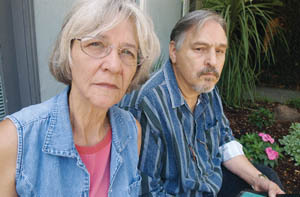
LOSING BATTLE? Colleen and Larry Phipps, former leaders of the local chapter of the National Alliance for the Mentally Ill, have been trying for years to convince Butte County to implement a mobile crisis unit like one operating in Redding. Proper intervention, they feel, could have kept their son from driving recklessly and causing the death of a young Chico man.
PHOTO BY TOM ANGEL
In court: Last November, Juan Carlos Lugo’s parents filed a civil suit against Donovan Phipps and his parents alleging wrongful death. Larry and Colleen Phipps said the case was recently settled for an amount covered by their homeowners’ insurance.In the end, Larry and Colleen Phipps couldn’t prevent the type of tragedy they most feared and fought to prevent.
On July 29, a jury found their son, Donovan Phipps, guilty of running a red light and crashing into the car of a young man, killing him.
Phipps stands to serve 32 years to life in prison for second-degree murder, felony hit-and-run and a misdemeanor conviction of resisting arrest.
Phipps’ parents are reluctant to talk about their concerns about how their son’s case was handled, in part because “it sounds like we’re being callous to the Lugo family,” Larry Phipps said.
Juan Carlos Lugo, 21, had just returned from a Mormon mission and was mourned by his close-knit family after his death following the Feb. 24, 2003, collision at The Esplanade and First Avenue. Lugo had just dropped off his brother at Pleasant Valley High School.
“My heart breaks for the family of young Juan Lugo and for the pain our son and family endure each day,” Colleen Phipps said.
Phipps’ parents believe his conviction was unjust in part because the jury failed to adequately consider their son’s history of mental illness.
They had hoped the court would accept a plea of not guilty by reason of insanity, because Phipps, 33 at the time, was in the throes of schizoaffective disorder, which led him to delusions when he wasn’t taking his medication.
“Our main problem is the logic and philosophy of the law that convicted him of murder,” Larry Phipps said. Since his son lacked intent to harm anyone, Phipps said, it would have been more appropriate for Donovan to face charges of manslaughter.
Deputy District Attorney Michael Sanderson, who prosecuted the case, acknowledged that Phipps “has some mental problems” but argued that, “He knew what he was doing on the morning of the collision, and he knew that it was wrong and he just didn’t care.
“I think justice would be served if he went away for 32 to life,” Sanderson said, adding that Lugo’s family is pleased with the verdict.
The Phippses have been known to the News & Review for more than seven years, as Colleen and Larry have been leaders of the local chapter of the National Alliance for the Mentally Ill.
The couple has repeatedly said they were worried something bad would happen if their son didn’t get help, but they never expected it would be an innocent person’s death.
The night before the collision, the Phippses had called police to report that Donovan was acting erratically, but no action was taken. “We knew he was in a crisis,” Colleen Phipps said. “We did everything we could within the law.”
Several years ago, Donovan Phipps was convicted of assault when, during a confrontation with police at his parents’ house, he threw an object out a window and struck a deputy. That “prior” weighed in on the lengthy sentence he faces.
In between that incident and the wreck that killed Juan Carlos Lugo, the Phippses said their son had been “a productive member of society, a law-abiding citizen, a mentor to others, an excellent employee and a caring and compassionate family member.”
They, along with other advocates for the mentally ill, have repeatedly pressed the county to create a mobile crisis unit and to implement a state law allowing involuntary treatment.
Phipps is scheduled to be sentenced on Sept. 14.
The Phippses hope for an appeal but are now in debt after mortgaging their house to pay lawyer Kevin Hyatt of Sacramento, who didn’t return the News & Review’s call for comment.
The post “Don’t Shoot My Son!” NAMI Advocate Writes About Son’s Incarceration appeared first on Pete Earley.
April 26, 2024
Popular Podcast Advocate Challenges Claim That Bipolar Sparks Creativity

(4-26-24) Are bipolar disorder and creativity linked?
In her groundbreaking 1996 book, Touched By Fire: Manic-Depressive Illness and the Artistic Temperament, Dr. Kay Redfield Jamison, argued that “many artists subject to exalted highs and despairing lows were in fact engaged in a struggle with clinically identifiable manic-depressive illness.”
Her book helped promote the idea that artistry/creativity and bipolar disorder are linked. The 2001 Academy Award winning movie, A Beautiful Mind, further cemented in the public’s mind that genius and serious mental illnesses go hand-in-hand.
Gabe Howard, a talented speaker, popular mental health podcaster, author, and tireless advocate for those living with bipolar disorder, writes that the “narrative of mental illness as the source of creativity is simply untrue.”
What’s your opinion? Are creative people more prone to bipolar disorder? Does the illness foster creativity?
What We Get Wrong About Being Bipolar | OpinionBy Gabe Howard, first published in Newsweek Magazine. Used with author’s permission.As someone who lives with bipolar disorder, there are many things about my life that society gets wrong, one of which is that people with bipolar disorder are more creative than the rest of the population.
March 30 is World Bipolar Day, a day in which we also celebrate Vincent Van Gogh—widely believed by experts to have bipolar disorder—and whose artistic ability is credited to his mental illness rather than to him as a person. A disorder that potentially caused him to mutilate his own body is glossed over because he was an incredible painter. This narrative of mental illness as the source of creativity is simply untrue.
I don’t have some hidden biological advantage buried in my brain that gives me extra talent. What I do  have is a talent that is credited to an illness with a death rate as high as 20 percent, rather than to me. This is an important distinction, because it is a trend that occurs repeatedly in my life. I make my living as a speaker and podcast host, and there are quite a few people who attribute my charismatic personality to bipolar mania. They look me dead in the eye and tell me they know I’m a great speaker because of an illness that has caused me an inestimable amount of pain.
have is a talent that is credited to an illness with a death rate as high as 20 percent, rather than to me. This is an important distinction, because it is a trend that occurs repeatedly in my life. I make my living as a speaker and podcast host, and there are quite a few people who attribute my charismatic personality to bipolar mania. They look me dead in the eye and tell me they know I’m a great speaker because of an illness that has caused me an inestimable amount of pain.
The Starry Night Painting
“The Starry Night” was painted when Van Gogh was a patient at the Saint-Paul asylum in Saint-Rémy in southern France. To put it more directly, he was suffering from depression so bad that he needed medical care. In general, being in a psychiatric facility is not discussed in a positive light, but because a beautiful painting was created during his time there, society overlooks those facts. And, while society is so quick to credit bipolar disorder with his artistic ability, they aren’t so quick to discuss—at least publicly—how bipolar disorder is responsible for his death. He died on July 27, 1890, two days after a self-inflicted gunshot wound to the chest.
The very notion that illnesses make people better is deeply disturbing.
Being told that our success is due to an illness carries not only an attached stigma and misplaced credit but could potentially harm someone who is trying to reach recovery. Cliches like “tortured artist” contribute to the idea that treatment is the enemy, implying if someone gets better they will lose the spark that makes them special. It would not be unreasonable for a person to believe that their talents, accomplishments, and achievements would go away if they were no longer sick. This kind of discouragement leads to people with bipolar to refuse medical intervention and support all the time.
I’m puzzled as to why our society needs to hold on to these tropes so tightly. Why can’t an illness that causes suffering, pain, and even death simply be bad and leave it at that? What protective factor is created in believing that while bipolar takes with one hand, it gives with the other? I’m fascinated by movies like “Silver Linings Playbook ” that, while getting many aspects of bipolar disorder correct, still fail to separate the main character, Pat Solitano (portrayed by Bradley Cooper), from his illness. The audience is left to believe that his personality is, simply, “bipolar.”
The reality is that people who are living well with bipolar disorder look just like everyone else, and may, like me, feel trapped by the fact that our disorder is so misunderstood that society has to find a way to boil down the essence of who we are to our diagnosis. If we want to explain greatness or amazement it’s a “spark of madness,” but when we speak about undesirable behavior, it’s described as “crazy.”
We need to look beyond the label of bipolar disorder, just as we need to look beyond any label that is supposed to solely define a person.
No one is just one thing and stereotyping is the shorthand of the lazy. We need to take the time to get to know people on an individual level and approach people living with bipolar disorder with an open mind.
And all this leads me back to Van Gogh. We need to recognize and appreciate all he was able to accomplish not because of his diagnosis, but in spite of it. Maybe then we can begin to see people with mental illness more as the unique people they are and less as punchlines to a convenient narrative.
ABOUT THE AUTHOR: Gabe Howard is an award-winning speaker, author, and podcast host who lives with bipolar disorder. He’s the host of the Webby Honored podcast, Inside Bipolar, for Healthline Media, and the author of Mental Illness Is an Asshole. He is a regular contributor to this blog. Learn more at gabehoward.com
The link to the podcast is https://psychcentral.com/blog/ibpThe post Popular Podcast Advocate Challenges Claim That Bipolar Sparks Creativity appeared first on Pete Earley.
April 23, 2024
My Lung Cancer Is In REMISSION! Targeted Therapy Is Working!

Celebrating a great PET Scan with Patti
(4-23-24) My PET scan shows that my Stage Four Lung Cancer is in REMISSION, which is defined as a “decrease or disappearance of signs of cancer.” I am ecstatic and feel as if my life has been given back to me.
Dr. Alexander Spira, my oncologist at Virginia Cancer Specialists, told Patti and me the good news yesterday, and we are overjoyed. He said my targeted therapy is working so well that the tumors in my right lung aren’t noticeable on my PET scan. This makes me wonder if I need to reconsider my journalistic skepticism about miracles. When my cancer was discovered in February by an ER doctor, it was suggested that I had six months to live.
The cancer is still there and it could emerge at any time, but it’s unlikely it will grow anytime soon while I continue taking Alecensa, a chemo-medication specifically designed to fight non-small-cell lung cancer that has spread. I will be taking 8 pills a day for life and every other month, undergoing scans and blood work.
Lung cancer happens when cells in the lung change (or mutate). Most often, this is because of exposure to dangerous chemicals that we breathe. But lung cancer can also happen in people with no known exposure to toxic substances. Unlike normal cells, cancer cells grow uncontrollably and cluster together to form a tumor, destroying healthy lung tissue around them. Symptoms usually do not appear until cancer cells spread to other parts of the body and prevent other organs from functioning properly. At this point, it is harder to treat lung cancer.
I have never smoked, but I spent a long time in prisons, jails and mental hospitals before smoking was banned in these institutions. In Russia, I lived with a couple who were avid smokers. I have no idea if it was second hand smoke or some other random chemical that I encountered or if it was exposure at all.
What I do know is that I am extremely lucky. My cancer was discovered before it had spread widely to my other organs. This was because I fell while hiking in December, breaking three ribs. This prompted me to visit a doctor because I was having trouble breathing and he discovered fluid in my lungs. It and blood tests indicated cancer.
Because the drug, Alecensa, is working so well, the plastic tube that was in my right lung to drain fluid is finally out. I have side effects but they are minor.
I want to THANK all of you who expressed your concern, offered prayers, and encouraged me – often by sharing your own experiences dealing with cancer. I am overwhelmed by the kindness that was showed me.
Today was the first day that I have awakened and not felt dread about my future.
Having a life-threatening illness caused me to focus and re-center my life on what really is important to me. And that is a blessing. My children offered me hope and my grandchildren brightened my days by giving me sloppy kisses and much needed distractions! Patti urged me – to be kind, think well of others, live a life with no regrets, hold those you love close, and always eat dessert first.
It’s a beautiful Spring day here in Northern Virginia and I am grateful.
The post My Lung Cancer Is In REMISSION! Targeted Therapy Is Working! appeared first on Pete Earley.
Pete Earley's Blog
- Pete Earley's profile
- 115 followers



